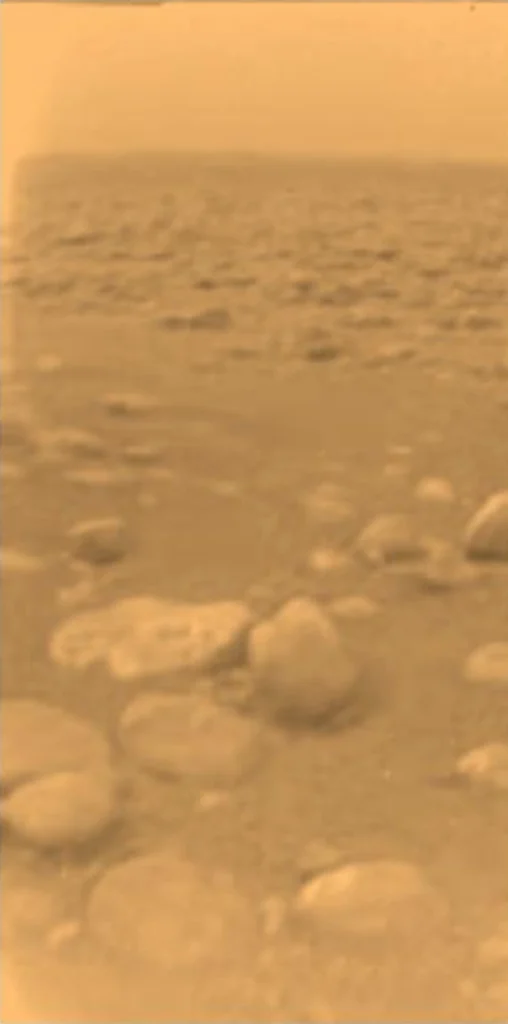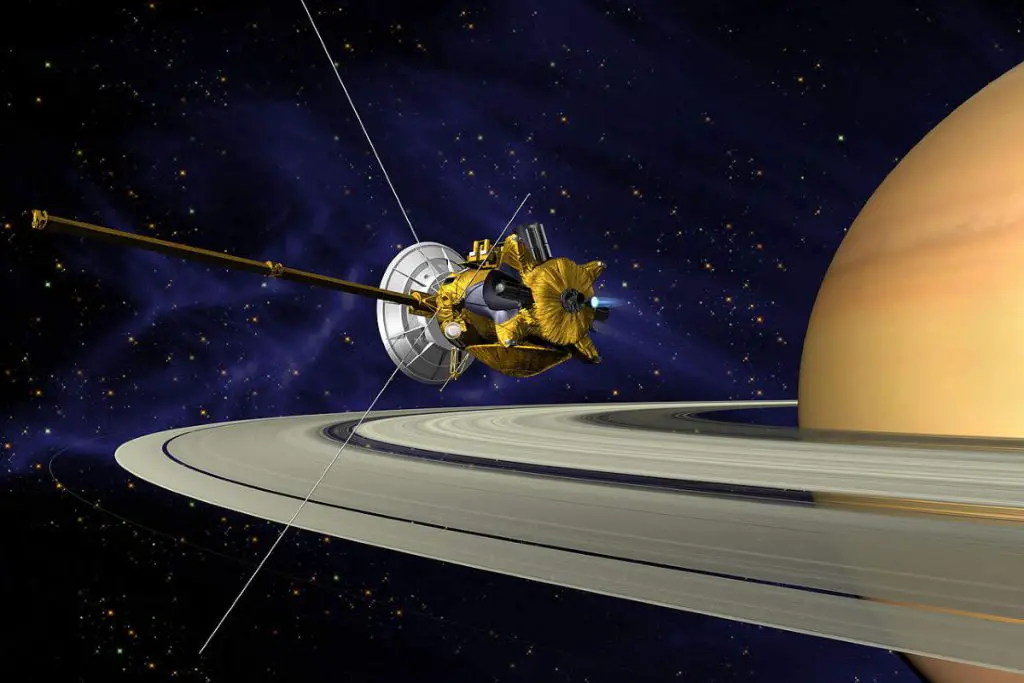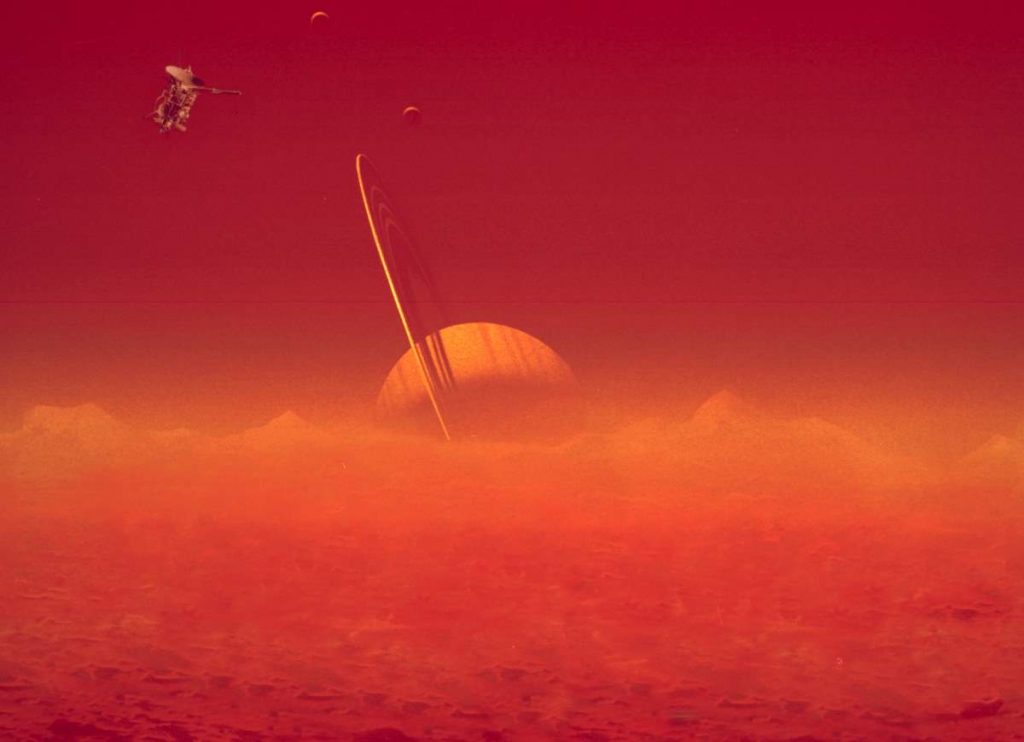On January 14, 2005, the Huygens spacecraft, the atmospheric entry robotic probe part of the Casini-Huygens mission performed the first soft landing on Titan. As of 2023, it is the only one accomplished in the outer Solar System and was also the first on a moon other than Earth’s, and the most distant landing ever.
January 14 story of what happened this day in Science, Technology, Astronomy, and Space Exploration history.
Huygens Spacecraft
Huygens was developed by the European Space Agency (ESA) and named after the Dutch astronomer, mathematician, and physicist Christiaan Huygens (14 April 1629 – 8 July 1695), discoverer of Saturn’s largest moon Titan. Huygens was also the first scientist who realized that Saturn had rings.
The probe was about 9 feet wide (2.7 meters) and weighed roughly 700 pounds (318 kilograms). It was built like a shellfish: a hard shell protected its delicate interior from high temperatures during the 2.5 hours of descent through the dense atmosphere of Saturn’s giant moon Titan.
The probe had two parts: the Entry Assembly Module and the Descent Module. The Entry Assembly Module carried the equipment to control Huygens after separation from Cassini, and a heat shield that acted as a brake and as thermal protection. The Descent Module contained the scientific instruments and three different parachutes that were deployed in sequence to control Huygens’ descent to the surface of Titan.
Cassini-Huygens mission (a joint mission of NASA, the European Space Agency, and the Italian Space Agency) was launched on October 15, 1997, from Cape Canaveral. The mission would place a spacecraft into Saturn’s orbit (Cassini) and land a probe (Huygens) on a moon in the outer solar system (Titan). Both achievements would be the first in history.
The journey to Saturn took seven years. Cassini was in Saturn’s orbit on July 1, 2004, and became the first spacecraft to orbit the ringed planet.
Titan
For some scientists, Saturn’s largest moon, Titan has been a higher priority for exploration than even Saturn itself, or any other planet in the solar system. Because:
- Titan may resemble what Earth was like billions of years ago, making this moon a kind of time machine that preserves in deep freeze many of the conditions that led to life on our planet.
- Titan is the only moon in our solar system that has a dense atmosphere. Furthermore, Titan’s atmosphere is made mostly of nitrogen, just like the Earth. There are smaller amounts of methane and ethane that break down into organic compounds, creating the moon’s smoggy orange haze.
- Titan’s extremely cold temperatures turn some gases into liquids. This led scientists to wonder if could Titan has oceans, made not of water, but of liquid methane and ethane.
These made Titan a major objective of the Cassini-Huygens mission.
The Most Distant Landing ever
Cassini released the Huygens probe on December 25, 2004. Huygens entered the atmosphere of Titan on January 14, 2005, and after a two-and-a-half-hour descent landed on the solid ground of Saturn’s biggest moon. It was the first (and still remains the only) soft landing on Titan.
It also still remains the most distant landing ever on another world, and the only landing on a body in the outer solar system.
![First soft landing on Titan: Huygens spacecraft on Titan [artist concept]](https://cdn-0.ourplnt.com/wp-content/uploads/2023/01/Huygens-spacecraft-on-Titan-artist-concept-1024x768.webp)
The first photo from Titan’s surface
The photo below was returned on January 14, 2005 by the Huygens probe during its successful descent to land on Titan.
To give a better indication of the actual color of the surface, the photo is colored, following processing to add reflection spectra data.
Initially thought to be rocks or ice blocks, they are more pebble-sized. The two rock-like objects just below the middle of the image are about 15 centimeters (6 inches) (left) and 4 centimeters (about 1.5 inches) (center) across respectively, at a distance of about 85 centimeters (about 33 inches) from Huygens.
The surface was darker than originally expected, consisting of a mixture of water and hydrocarbon ice. There was also evidence of erosion at the base of these objects, indicating possible fluvial activity.

The spacecraft transmitted data back to Earth for about 90 minutes. The data and images it gathered provided new insights into Titan’s atmosphere and surface.
Some of the key findings about Titan from the Cassini/Huygens mission include:
- Titan has a thick, nitrogen-rich atmosphere that is similar in composition to Earth’s early atmosphere.
- The surface of Titan is covered in a layer of organic materials, including hydrocarbons and methane.
- The spacecraft discovered that Titan has lakes and seas of liquid methane and ethane, as well as rivers and channels that appear to be shaped by liquid erosion. Scientists have known that the much larger northern seas are filled with methane, but finding the smaller northern lakes filled mostly with methane was a surprise.
- The Huygens data also revealed that Titan has a complex geology, with mountains, dunes, and a diverse range of terrains.
- The mission also found that Titan has a dynamic atmosphere, with weather patterns that include methane rain and large clouds. It is similar to Earth’s water cycle with one major difference: instead of water evaporating from seas, forming clouds and rain, Titan does it all with methane and ethane.
- It revealed that Titan has a subsurface ocean of water and ammonia beneath its icy crust.
Video: Huygens’ Titan Touchdown [actual images]
Sources
- Huygens Probe on the NASA Solar System website
- Huygens mission page on the NASA Solar System website
- Cassini-Huygens mission page on the NASA Jet Propulsion Laboratory website
- Huygens (spacecraft) on Wikipedia
- Moon Landings: All-Time List [1966-2025] - February 2, 2025
- What Is Max-Q and Why Is It Important During Rocket Launches? - January 16, 2025
- Top 10 Tallest Rockets Ever Launched [2025 Update] - January 16, 2025
![Huygens spacecraft on Titan [artist concept]](https://cdn-0.ourplnt.com/wp-content/uploads/2023/01/Huygens-spacecraft-on-Titan-artist-concept.jpg)

